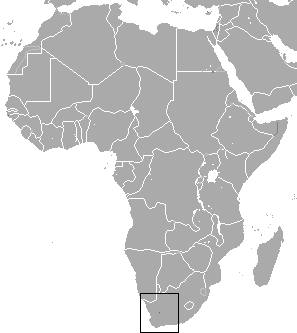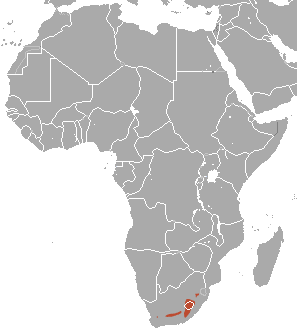
Golden moles are small insectivorous burrowing mammals endemic to Sub-Saharan Africa. They comprise the family Chrysochloridae and as such they are taxonomically distinct from the true moles, family Talpidae, and other mole-like families, all of which, to various degrees, they resemble as a result of evolutionary convergence. There are 21 species. Some are relatively common, whereas others are rare and endangered.

The clade Tenrecoidea or Afrosoricida contains the golden moles of Southern Africa, the otter shrews of equatorial Africa and the tenrecs of Madagascar. These three groups of small mammals were for most of the 19th and 20th centuries regarded as a part of the Insectivora or Lipotyphla. Both groups, as traditionally used, are polyphyletic.

The Somali golden mole is a golden mole endemic to Somalia. In 1964, Dr. Alberto Simonetta of the University of Florence discovered the mole's jaw and ear bone fragments in a barn owl pellet in Jowhar, Somalia. The Somali golden mole differs from the other species in its family (Chrysochloridae) because the shape of its jaw is distinct; although the length of the lower jaw fits within the size range of the skulls of species Amblysomus leucorhinus and Amblysomus sclateri, the width of the ascending parts of the jaw is much bigger (2mm) than that of the species it most closely matches.

Visagie's golden mole is a small, insectivorous mammal of the family Chrysochloridae, the golden moles, endemic to South Africa.

The woodland thicket rat is a species of rodent in the family Muridae. It is found in Angola, Burundi, Democratic Republic of the Congo, Kenya, Malawi, Mozambique, Rwanda, South Africa, South Sudan, Eswatini, Tanzania, Zambia, and Zimbabwe. Its natural habitats are subtropical or tropical dry forest, subtropical or tropical moist lowland forest, subtropical or tropical dry shrubland, subtropical or tropical moist shrubland, subtropical or tropical high-altitude shrubland, subtropical or tropical dry lowland grassland, arable land, pastureland, and urban areas.

The fynbos golden mole is a species of mammal in the golden mole family, Chrysochloridae. It is endemic to South Africa.
Amblysomus is a genus of the golden mole family, Chrysochloridae, comprising five species of the small, insect-eating, burrowing mammals endemic to Southern Africa. All five species can be found in South Africa and some are also found in Eswatini and Lesotho.

The Hottentot golden mole is a species of mammal in the golden mole family, Chrysochloridae. It is found in South Africa, Eswatini, and possibly Lesotho. Its natural habitats are temperate forests, subtropical or tropical dry and moist lowland forest and dry shrubland and grassland, Mediterranean-type shrubby vegetation, savanna, temperate grassland, sandy shores, arable land, pastureland, plantations, rural gardens, and urban areas.

Marley's golden mole is a species of burrowing mammal in the golden mole family, Chrysochloridae. It is found in South Africa and possibly Eswatini. It has been separated from Amblysomus hottentotus by Bronner. Its natural habitat is indigenous forests and moist grassland, and also gardens. It is classified as Endangered in the IUCN Red List of Threatened Species. The main threats it faces are habitat degradation, either through overgrazing by cattle or the removal of vegetation for firewood, and urbanization.

The highveld golden mole is a species of mammal in the golden mole family, Chrysochloridae. It is found in South Africa and Eswatini. Its natural habitats are forests, moist savanna, temperate shrubland and grassland, subtropical or tropical dry lowland grassland, arable land, pastureland, plantations, rural gardens, and urban areas.

The Congo golden mole is a species of mammal in the family Chrysochloridae. It is found in Angola, Cameroon, Central African Republic, Republic of the Congo, and Democratic Republic of the Congo. Its natural habitats are subtropical or tropical forest, arable land, pastureland, plantations, and rural gardens.

The yellow golden mole is a species of mammal in the family Chrysochloridae. It is found in Mozambique, South Africa, and Zimbabwe. The yellow golden mole's natural habitats are subtropical or tropical dry and moist lowland forests, savanna, arable land, pasture, plantations, and rural gardens.

Arends' golden mole is a species of mammal in the family Chrysochloridae. It is found in Mozambique and Zimbabwe. Its natural habitats are temperate forests, subtropical or tropical dry, and moist montane forests, dry lowland grassland, arable land, pasture, plantations, rural gardens, and urban areas.
Duthie's golden mole is a species of mammal in the family Chrysochloridae. It is endemic to South Africa. Its natural habitats are subtropical or tropical moist lowland forests, moist savanna, temperate grassland, arable land, pastureland, plantations, rural gardens, and urban area. The specific name duthieae was given in honour of Dr. Augusta Vera Duthie, a South African botanist.

Sclater's golden mole is a species of mammal in the family Chrysochloridae. It is found in Lesotho and South Africa. Its natural habitats are subtropical or tropical dry and high-altitude shrubland, Mediterranean-type shrubby vegetation, temperate grassland, arable land, pastureland, rural gardens, and urban areas. This species is locally common, and the International Union for Conservation of Nature has assessed its conservation status as being of "least concern".

Stuhlmann's golden mole is a species of mammal in the family Chrysochloridae. It is found in Cameroon, Democratic Republic of the Congo, Kenya, Tanzania, and Uganda. Its natural habitats are subtropical or tropical moist montane forest and high-elevation shrubland, Mediterranean-type shrubby vegetation, subtropical or tropical dry grassland, arable land, and pasture.

De Winton's golden mole is a species of mammal in the family Chrysochloridae. It is endemic to South Africa. Its natural habitats are subtropical dry shrubland, Mediterranean-type shrubby vegetation, and sandy shores. It is threatened by habitat destruction. It is "critically endangered" and may be extinct.

The short-tailed shrew tenrec is a species of mammal in the family Tenrecidae. It is endemic to Madagascar. Its natural habitats are subtropical and tropical dry and moist lowland forests.
The ochre mole-rat is a species of rodent in the family Bathyergidae. It is found in Central African Republic, Democratic Republic of the Congo, South Sudan, and Uganda. Its natural habitats are moist savanna, subtropical or tropical dry shrubland, subtropical or tropical dry lowland grassland, caves, and arable land.
















